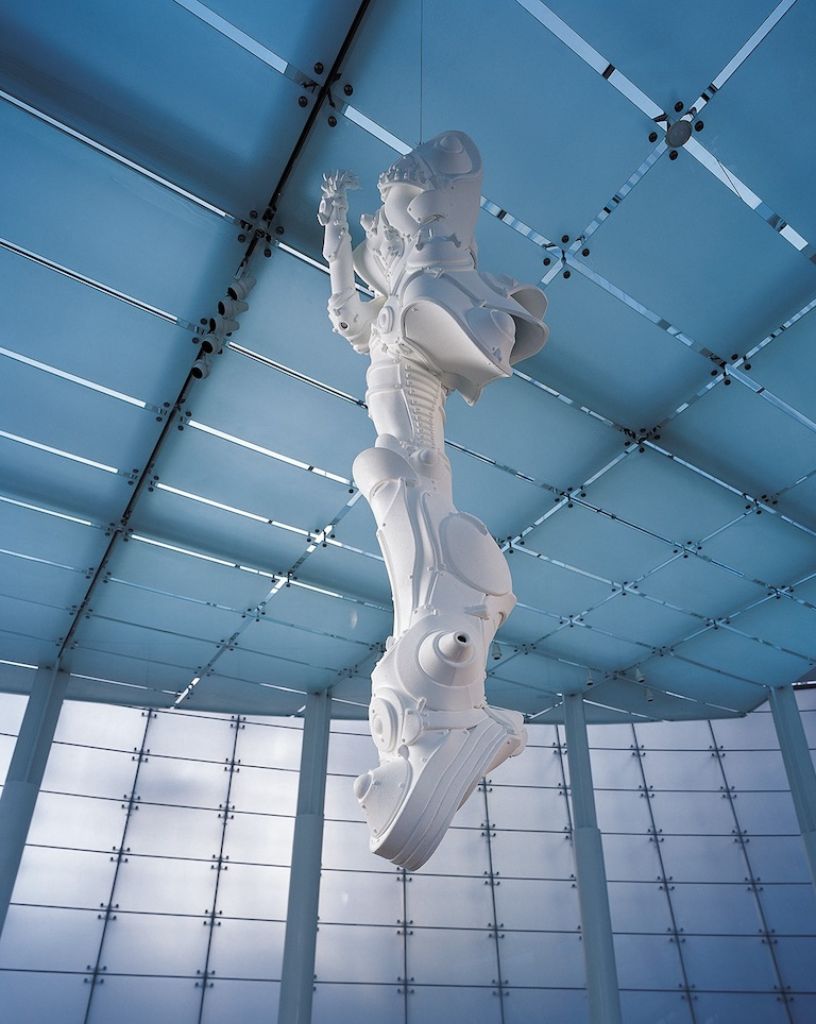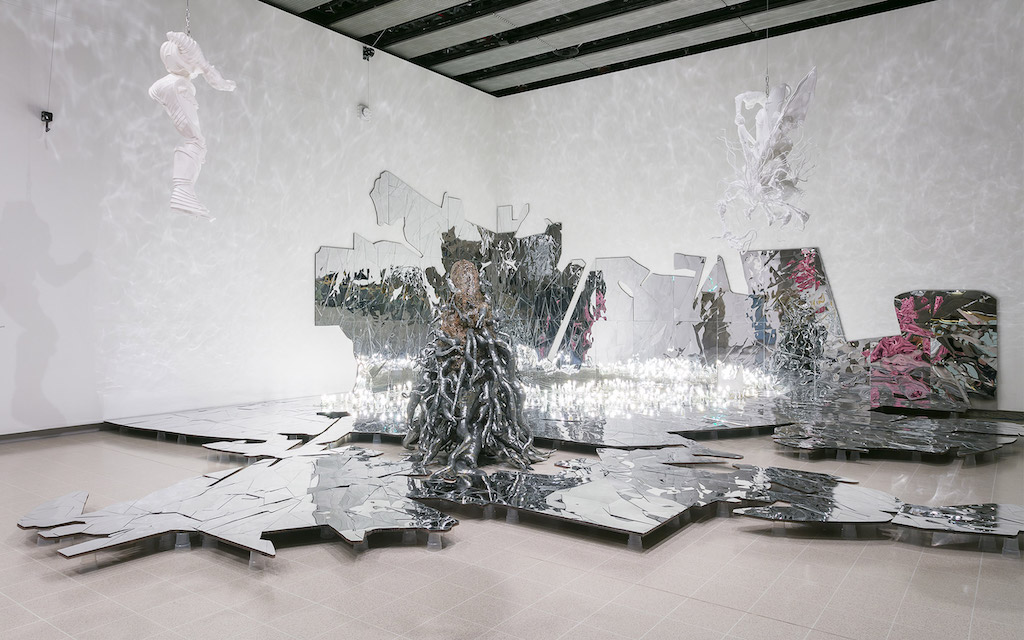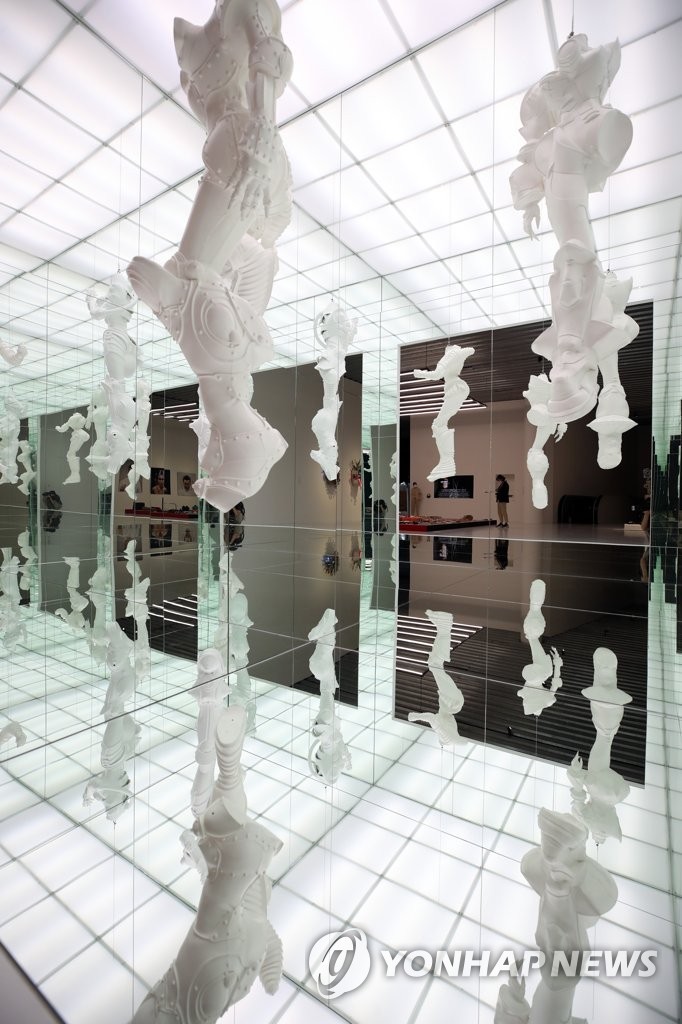PART III | BUL IN A CHINA SHOP: LEE BUL’S PARADOXICAL CYBORGS
CRITIQUING THE SEXY CYBORG?
Lee Bul’s cyborg sculptures take issue with the cyborg in application, especially the representation of the sexy female cyborg in media. However, because of the artist’s association with feminist art (despite her rejection of the term), scholars have assumed her work has an innately feminist meaning or interpretation. As I argue below, a critical examination of how her works deal with the sexualized female body and if they can be considered feminist complicates such a straightforward connection. Cyborg W1-W10 first and foremost attempt to reject and undermine how female cyborgs are problematically presented in anime, yet their effect is ultimately unresolved and ambiguous due to the changing nature of their display.
As previously discussed, in anime like Ghost in the Shell, female cyborg bodies are objectified for the assumed male audience in lingering and provocative shots that present the sexualized female form for visual consumption. Motoko Kusanagi’s body, for example, is characterized by tactile realism and an idealized rendering of female features that appeals to the male gaze. Fan Xiaoyan’s Physical Attachment similarly presents the female cyborg body as an erotic site of visual consumption in style and presentation. Her realistic style, which mimics the natural coloring of skin, nipples, and facial features visually brings the sculptures closer to real human bodies, allowing them to be more readily eroticized. Additionally, the organic parts of the bodies are representations of a highly sexualized female form characterized by thin limbs, small waists, and round, full breasts. Despite the radical conception of the cyborg as a figure that can confuse gender boundaries, in these two examples the cyborg is clearly gendered as female, and its radical potential is contained within the paradigm of the female body as a sexual object. Lee’s sculptures have more ambiguous relationship with this paradigm. They exhibit the visual features of the sexualized female cyborg form present in anime and Physical Attachment, particularly the emphasis on breasts, yet their visual form disrupts and ridicules an eroticized viewing experience.
In Cyborg W1-W10, female sex characteristics are presented in an artificially exaggerated way, undermining the titillating viewing experience present in anime depictions of cyborgs. Breasts take warped shapes like pointed cones and rectangular protrusions. Waists are made excessively small in proportion to the shoulders and hips, creating unnatural and disturbing curves. The female aspects of the cyborg body are amplified and distorted to become grotesque, undermining their sexual desirability. The connection between her sculptures and the problematic objectification present in anime is one aspect of Lee Bul’s critique of the cyborg. In comparison with Fan Xiaoyan, both artists have used the features characteristic of female bodies, like wide hips and breasts, but they do so in entirely different ways. While Fan’s cyborgs resemble real women with added mechanical attachments, Lee’s sculptures are more abstract. Cyborg W3 (figure 28), in contrast to Fan’s cyborgs, is headless, monochromatic, and has distorted body features. The mechanical attachments are here less “attached” than they are an essential part of the cyborg’s body. This both gives the figure more cohesion and distances it from the appearance of organic bodies. This is not simply a woman with added machine parts, but an entirely new, hybrid being. According to scholar Jeon Hyesook, these “‘disabled-female-cyborgs’ break the conclusiveness of technology that was considered to be the domain of men, and by doing so, they eliminate the collusion of ‘machine-power,’ deactivate the male gaze, and become hybrids that exist beyond boundaries.”[116] Here Jeon argues that the female cyborgs contradict the common perception that men are better-suited to work with technology and break the male dominance of technology by integrating the female body with the machine. Lee alluded to the traditional sexualization of the female body by making the cyborgs curvy, while simultaneously impeding the viewer from sexualizing the sculpture. Her cyborgs strike a delicate balance that can be read as criticizing the sexualization of women, while Fan Xiaoyan’s do not.
However, the varying types of display that are possible with these sculptures complicates the view that they represent a straightforward, feminist repudiation of the sexy cyborg form. Fan Xiaoyan alluringly presented the cyborg body directly on the floor, variously posed on their hands and knees (figure 16) or laying down (figure 15),which conveys a provocative or passive presence that invites the erotic gaze of the spectator. Furthermore, since the cyborg in Physical Attachment-03 is splayed out on the floor, the viewer is literally looking down at the piece, a physical manifestation of the power dynamic between viewer and viewed. This dynamic is not so readily applied to Lee Bul’s cyborgs, who maintain an inconclusive relationship with the viewer due to their variable display.
Because Cyborg W1-W10 are hung, the viewer is able to see the entire cyborg body without the interference of a pedestal or base. Each sculpture can be consumed from many angles, including from below, and their lack of heads, limbs, and assistive devices also suggests a lack of physical agency and potential, and thus erotic consumption, as in Fan’s sculptures. While the sculptures can be observed by the viewer, their headless bodies cannot reciprocate a gaze. As in Physical Attachment, Lee’s sculptures replicate the historical visual hierarchy that categorizes men as active lookers and women as objects that are looked at. The lack of a pedestal also eliminates a barrier that visually and physically prevents the viewer from approaching the sculptures, allowing for an invasion of their “personal space,” so to speak. Unlike the majority of figurative art, which has some impediment or demarcation between the viewer and the work of art (for example, a frame, vitrine, or pedestal), these headless and immobile female bodies can be brought into close contact with the viewer. Therefore, the viewer has the power of the unrestrained gaze: not only can they consume the female body from all angles, they can do so from close proximity. In addition, the sculptures are larger than life-size, which allows for a closer inspection of the cyborg body, especially if they are hung closer to the ground. Inviting intimate observation, the female body is thus subject to the viewer’s complete visual, and potentially erotic, consumption. Alternatively, the works can be hung farther off the ground, creating varying degrees of distance from the viewer that could impede a voyeuristic viewing experience. Hanging the cyborgs at an elevated height, for example, would make the experience of contemplating the female body physically uncomfortable and difficult to sustain over long periods of time. In this scenario, the monumental scale of the sculptures, as well as the sci-fi effect of a hovering sculpture far above one’s head, fully rejects the male gaze. In practice, different museum or gallery spaces utilize vastly different hangings of the sculptures (see figure 42), and therefore there cannot be a universal interpretation of Lee Bul’s series. However, this inconsistency in display signals the ambiguity of a feminist interpretation; when hung low, the sculptures are more easily eroticized, while a hang that places them far away from the viewer thwarts the erotic consumption of the female body.
Figure 31: Lee Bul, Cyborg W6, 2001. Hand-cut EVA panels on FRP, polyurethane coating, 232 x 67 x 67 cm. Photo: Kim Hyun-soo. Photo Courtesy: Leeum, Samsung Museum of Art.
Figure 26: Lee Bul, Cyborg W1, 1998. Cast silicone, polyurethane filling, paint pigment, 185 x 56 x 58 cm. Photo: Yoon Hyung-moon. Courtesy of the artist.
Figure 27: Lee Bul, Cyborg W2, 1998. Cast silicone, polyurethane filling, paint pigment, 185 x 74 x 58 cm. Photo: Yoon Hyung-moon. Courtesy of the artist.
Figure 28: Lee Bul, Cyborg W3, 1998. Cast silicone, polyurethane filling, paint pigment, 185 x 81 x 58 cm. Photo: Yoon Hyung-moon. Courtesy of the artist.
Figure 41: Lee Bul, Cyborg W7, 2000. Hand-cut EVA panels on FRP, polyurethane coating. Photo: Jeon Byung-cheol. Courtesy of the artist.
Figure 42: Installation Gallery (click to enlarge and see captions)
Lee Bul’s cyborg sculptures take issue with the cyborg in application, especially the representation of the sexy female cyborg in media. However, because of the artist’s association with feminist art (despite her rejection of the term), scholars have assumed her work has an innately feminist meaning or interpretation. As I argue below, a critical examination of how her works deal with the sexualized female body and if they can be considered feminist complicates such a straightforward connection. Cyborg W1-W10 first and foremost attempt to reject and undermine how female cyborgs are problematically presented in anime, yet their effect is ultimately unresolved and ambiguous due to the changing nature of their display.
Figure 31: Lee Bul, Cyborg W6, 2001. Hand-cut EVA panels on FRP, polyurethane coating, 232 x 67 x 67 cm. Photo: Kim Hyun-soo. Photo Courtesy: Leeum, Samsung Museum of Art.
As previously discussed, in anime like Ghost in the Shell, female cyborg bodies are objectified for the assumed male audience in lingering and provocative shots that present the sexualized female form for visual consumption. Motoko Kusanagi’s body, for example, is characterized by tactile realism and an idealized rendering of female features that appeals to the male gaze. Fan Xiaoyan’s Physical Attachment similarly presents the female cyborg body as an erotic site of visual consumption in style and presentation. Her realistic style, which mimics the natural coloring of skin, nipples, and facial features visually brings the sculptures closer to real human bodies, allowing them to be more readily eroticized. Additionally, the organic parts of the bodies are representations of a highly sexualized female form characterized by thin limbs, small waists, and round, full breasts. Despite the radical conception of the cyborg as a figure that can confuse gender boundaries, in these two examples the cyborg is clearly gendered as female, and its radical potential is contained within the paradigm of the female body as a sexual object. Lee’s sculptures have more ambiguous relationship with this paradigm. They exhibit the visual features of the sexualized female cyborg form present in anime and Physical Attachment, particularly the emphasis on breasts, yet their visual form disrupts and ridicules an eroticized viewing experience.
Figure 26: Lee Bul, Cyborg W1, 1998. Cast silicone, polyurethane filling, paint pigment, 185 x 56 x 58 cm. Photo: Yoon Hyung-moon. Courtesy of the artist.
In Cyborg W1-W10, female sex characteristics are presented in an artificially exaggerated way, undermining the titillating viewing experience present in anime depictions of cyborgs. Breasts take warped shapes like pointed cones and rectangular protrusions. Waists are made excessively small in proportion to the shoulders and hips, creating unnatural and disturbing curves. The female aspects of the cyborg body are amplified and distorted to become grotesque, undermining their sexual desirability. The connection between her sculptures and the problematic objectification present in anime is one aspect of Lee Bul’s critique of the cyborg. In comparison with Fan Xiaoyan, both artists have used the features characteristic of female bodies, like wide hips and breasts, but they do so in entirely different ways. While Fan’s cyborgs resemble real women with added mechanical attachments, Lee’s sculptures are more abstract. Cyborg W3 (figure 28), in contrast to Fan’s cyborgs, is headless, monochromatic, and has distorted body features. The mechanical attachments are here less “attached” than they are an essential part of the cyborg’s body. This both gives the figure more cohesion and distances it from the appearance of organic bodies. This is not simply a woman with added machine parts, but an entirely new, hybrid being. According to scholar Jeon Hyesook, these “‘disabled-female-cyborgs’ break the conclusiveness of technology that was considered to be the domain of men, and by doing so, they eliminate the collusion of ‘machine-power,’ deactivate the male gaze, and become hybrids that exist beyond boundaries.”[116] Here Jeon argues that the female cyborgs contradict the common perception that men are better-suited to work with technology and break the male dominance of technology by integrating the female body with the machine. Lee alluded to the traditional sexualization of the female body by making the cyborgs curvy, while simultaneously impeding the viewer from sexualizing the sculpture. Her cyborgs strike a delicate balance that can be read as criticizing the sexualization of women, while Fan Xiaoyan’s do not.
Figure 27: Lee Bul, Cyborg W2, 1998. Cast silicone, polyurethane filling, paint pigment, 185 x 74 x 58 cm. Photo: Yoon Hyung-moon. Courtesy of the artist.
Figure 28: Lee Bul, Cyborg W3, 1998. Cast silicone, polyurethane filling, paint pigment, 185 x 81 x 58 cm. Photo: Yoon Hyung-moon. Courtesy of the artist.
However, the varying types of display that are possible with these sculptures complicates the view that they represent a straightforward, feminist repudiation of the sexy cyborg form. Fan Xiaoyan alluringly presented the cyborg body directly on the floor, variously posed on their hands and knees (figure 16) or laying down (figure 15),which conveys a provocative or passive presence that invites the erotic gaze of the spectator. Furthermore, since the cyborg in Physical Attachment-03 is splayed out on the floor, the viewer is literally looking down at the piece, a physical manifestation of the power dynamic between viewer and viewed. This dynamic is not so readily applied to Lee Bul’s cyborgs, who maintain an inconclusive relationship with the viewer due to their variable display.
Figure 41: Lee Bul, Cyborg W7, 2000. Hand-cut EVA panels on FRP, polyurethane coating. Photo: Jeon Byung-cheol. Courtesy of the artist.
Because Cyborg W1-W10 are hung, the viewer is able to see the entire cyborg body without the interference of a pedestal or base. Each sculpture can be consumed from many angles, including from below, and their lack of heads, limbs, and assistive devices also suggests a lack of physical agency and potential, and thus erotic consumption, as in Fan’s sculptures. While the sculptures can be observed by the viewer, their headless bodies cannot reciprocate a gaze. As in Physical Attachment, Lee’s sculptures replicate the historical visual hierarchy that categorizes men as active lookers and women as objects that are looked at. The lack of a pedestal also eliminates a barrier that visually and physically prevents the viewer from approaching the sculptures, allowing for an invasion of their “personal space,” so to speak. Unlike the majority of figurative art, which has some impediment or demarcation between the viewer and the work of art (for example, a frame, vitrine, or pedestal), these headless and immobile female bodies can be brought into close contact with the viewer. Therefore, the viewer has the power of the unrestrained gaze: not only can they consume the female body from all angles, they can do so from close proximity. In addition, the sculptures are larger than life-size, which allows for a closer inspection of the cyborg body, especially if they are hung closer to the ground. Inviting intimate observation, the female body is thus subject to the viewer’s complete visual, and potentially erotic, consumption. Alternatively, the works can be hung farther off the ground, creating varying degrees of distance from the viewer that could impede a voyeuristic viewing experience. Hanging the cyborgs at an elevated height, for example, would make the experience of contemplating the female body physically uncomfortable and difficult to sustain over long periods of time. In this scenario, the monumental scale of the sculptures, as well as the sci-fi effect of a hovering sculpture far above one’s head, fully rejects the male gaze. In practice, different museum or gallery spaces utilize vastly different hangings of the sculptures (see figure 42), and therefore there cannot be a universal interpretation of Lee Bul’s series. However, this inconsistency in display signals the ambiguity of a feminist interpretation; when hung low, the sculptures are more easily eroticized, while a hang that places them far away from the viewer thwarts the erotic consumption of the female body.
Figure 42: Installation Gallery (click to enlarge and see captions)









